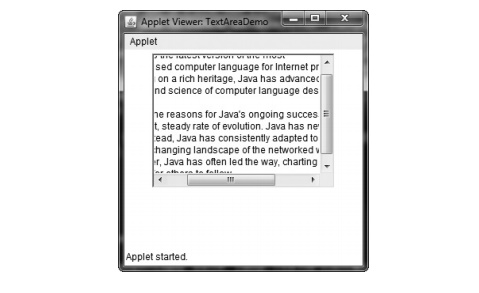Chapter: Java The Complete Reference : The Java Library : Using AWT Controls, Layout Managers, and Menus
Using a TextArea - AWT Controls
Using a TextArea
Sometimes a single line of text input is not enough for a given
task. To handle these situations, the AWT includes a simple multiline editor
called TextArea. Following are the
constructors for TextArea:
TextArea( ) throws HeadlessException
TextArea(int numLines,
int numChars) throws
HeadlessException TextArea(String str)
throws HeadlessException
TextArea(String str, int numLines, int numChars) throws HeadlessException
TextArea(String str, int numLines, int numChars,
int sBars) throws HeadlessException
Here, numLines specifies
the height, in lines, of the text area, and numChars
specifies its width, in characters. Initial text can be specified by str. In the fifth form, you can specify
the scroll bars that you want the control to have. sBars must be one of these values:

TextArea is a subclass of TextComponent. Therefore, it supports
the getText( ), setText( ),
getSelectedText( ), select( ), isEditable( ), and setEditable( ) methods described in the preceding section.
TextArea adds the following editing
methods:
void append(String str)
void insert(String str,
int index)
void replaceRange(String str,
int startIndex, int endIndex)
The append( ) method
appends the string specified by str
to the end of the current text. insert(
) inserts the string passed in str
at the specified index. To replace text, call replaceRange( ). It replaces the characters from startIndex to
endIndex–1, with the replacement text passed in str.
Text areas are almost self-contained controls. Your program incurs
virtually no management overhead. Normally, your program simply obtains the
current text when it is needed. You can, however, listen for TextEvents, if you choose.
The following program creates a TextArea control:
//
Demonstrate TextArea.
import
java.awt.*; import java.applet.*; /*
<applet
code="TextAreaDemo" width=300 height=250> </applet>
*/
public
class TextAreaDemo extends Applet { public void init() {
String
val =
"Java
8 is the latest version of the most\n" +
"widely-used
computer language for Internet programming.\n" + "Building on a rich
heritage, Java has advanced both\n" + "the art and science of
computer language design.\n\n" +
"One
of the reasons for Java's ongoing success is its\n" + "constant,
steady rate of evolution. Java has never stood\n" + "still. Instead,
Java has consistently adapted to the\n" + "rapidly changing landscape
of the networked world.\n" + "Moreover, Java has often led the way,
charting the\n" + "course for others to follow.";
TextArea
text = new TextArea(val, 10, 30); add(text);
}
}
Here is sample output from the TextAreaDemo
applet:

Related Topics